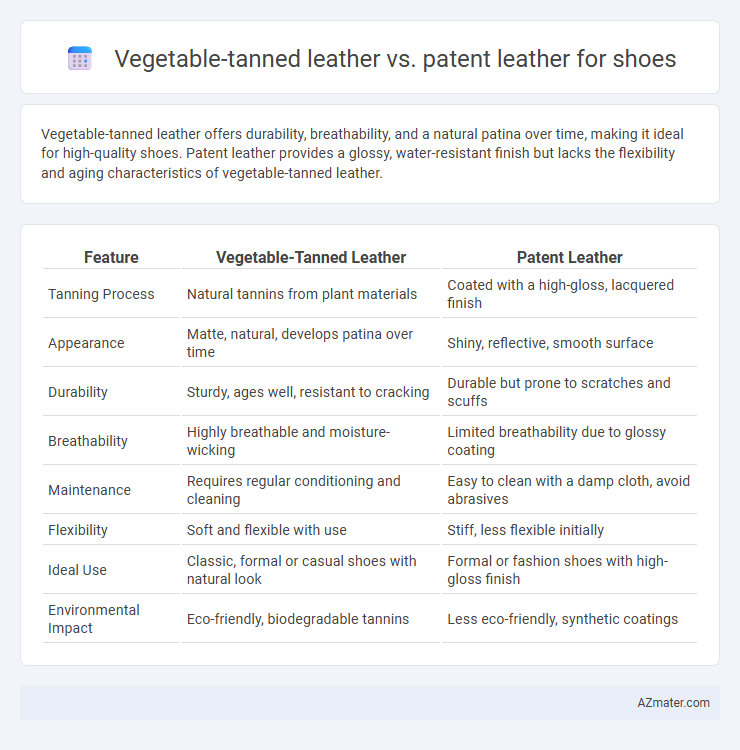Vegetable-tanned leather offers durability, breathability, and a natural patina over time, making it ideal for high-quality shoes. Patent leather provides a glossy, water-resistant finish but lacks the flexibility and aging characteristics of vegetable-tanned leather.
Table of Comparison
| Feature | Vegetable-Tanned Leather | Patent Leather |
|---|---|---|
| Tanning Process | Natural tannins from plant materials | Coated with a high-gloss, lacquered finish |
| Appearance | Matte, natural, develops patina over time | Shiny, reflective, smooth surface |
| Durability | Sturdy, ages well, resistant to cracking | Durable but prone to scratches and scuffs |
| Breathability | Highly breathable and moisture-wicking | Limited breathability due to glossy coating |
| Maintenance | Requires regular conditioning and cleaning | Easy to clean with a damp cloth, avoid abrasives |
| Flexibility | Soft and flexible with use | Stiff, less flexible initially |
| Ideal Use | Classic, formal or casual shoes with natural look | Formal or fashion shoes with high-gloss finish |
| Environmental Impact | Eco-friendly, biodegradable tannins | Less eco-friendly, synthetic coatings |
Introduction to Vegetable-Tanned and Patent Leather
Vegetable-tanned leather undergoes a natural tanning process using tannins from tree bark and plant extracts, resulting in a durable, breathable material with a rich, earthy scent and a matte finish that ages gracefully over time. Patent leather, by contrast, is coated with a glossy, high-shine synthetic finish that provides a waterproof, smooth surface ideal for formal and dress shoes. Both types offer unique aesthetics and performance characteristics, with vegetable-tanned leather favored for its natural feel and longevity, while patent leather excels in creating striking, polished footwear.
What is Vegetable-Tanned Leather?
Vegetable-tanned leather is crafted using natural tannins derived from tree bark and plant extracts, resulting in a durable and biodegradable material that develops a rich patina over time. This type of leather is prized for its breathability, strength, and ability to mold to the foot, making it a popular choice for high-quality shoes. Unlike patent leather, which has a glossy, synthetic surface, vegetable-tanned leather offers a matte finish with natural texture and color variations.
Defining Patent Leather
Patent leather is a type of leather characterized by its high-gloss, shiny finish achieved through a coating process, typically using polyurethane or a similar synthetic substance. Unlike vegetable-tanned leather, which is tanned using natural tannins from plant sources resulting in a matte or natural finish, patent leather's surface is smooth and reflective, offering a distinct aesthetic suitable for formal or fashion-forward footwear. This glossy coating also provides water-resistant properties, making patent leather less breathable but easier to clean compared to the more organic and porous vegetable-tanned leather.
Aesthetic Differences: Matte vs. Glossy Finish
Vegetable-tanned leather features a natural, matte finish that develops a rich patina over time, highlighting the leather's texture and organic appeal. Patent leather is known for its distinctive glossy, high-shine surface achieved through a lacquer or plastic coating, offering a sleek and polished aesthetic. The matte finish of vegetable-tanned leather provides a subtle, classic look, while patent leather's glossy finish delivers a bold, eye-catching style ideal for formal occasions.
Durability and Longevity Comparison
Vegetable-tanned leather offers superior durability and develops a rich patina over time, making it highly resilient for long-term shoe use. Patent leather, while visually striking with its glossy finish, is more prone to cracking and scuffing, which can significantly reduce its lifespan. For shoes requiring longevity and robust wear resistance, vegetable-tanned leather is the preferred choice due to its natural strength and aging qualities.
Comfort and Breathability in Shoes
Vegetable-tanned leather offers superior breathability and molds to the foot over time, enhancing overall comfort by allowing moisture to escape and reducing sweat buildup. Patent leather, coated with a glossy, non-porous finish, limits airflow which can lead to increased heat and discomfort during extended wear. For shoes prioritizing long-lasting comfort and natural breathability, vegetable-tanned leather remains the preferred material.
Eco-Friendliness and Sustainability
Vegetable-tanned leather uses natural tannins from tree bark and plant extracts, making it biodegradable and less toxic compared to the synthetic chemicals in patent leather production. Patent leather undergoes heavy chemical processes and coatings with plastic finishes, which hinder biodegradability and increase environmental pollution. Choosing vegetable-tanned leather enhances sustainability by reducing chemical waste and supporting eco-friendly leather craftsmanship.
Maintenance and Care Requirements
Vegetable-tanned leather shoes require regular conditioning with natural oils or creams to prevent drying and cracking, while patent leather shoes mainly need gentle wiping with a damp cloth to maintain their glossy finish. Avoid exposing vegetable-tanned leather to excessive moisture and direct sunlight to preserve its durability, whereas patent leather is more water-resistant but prone to scuff marks that require special patent leather cleaners or protective sprays. Both types benefit from proper storage in a cool, dry place away from heat sources to extend their lifespan and maintain appearance.
Best Uses and Style Recommendations
Vegetable-tanned leather offers a natural, breathable finish ideal for durable, classic dress shoes and casual footwear, complementing styles that emphasize craftsmanship and aging character. Patent leather, known for its glossy, high-shine surface, suits formal events and fashion-forward shoes like evening wear, loafers, and dance shoes where a polished, eye-catching appearance is desired. For versatile daily wear, vegetable-tanned leather delivers comfort and aging beauty, while patent leather excels in sophisticated, statement-making designs requiring a sleek finish.
Which Leather is Right for Your Shoes?
Vegetable-tanned leather offers durability, breathability, and a natural aging process, making it ideal for those seeking comfort and long-term wear in shoes. Patent leather provides a glossy, water-resistant finish suited for formal occasions and styles requiring a polished appearance. Choosing the right leather depends on your preference for aesthetics, maintenance, and the intended use of the shoes.

Infographic: Vegetable-tanned leather vs Patent leather for Shoe
 azmater.com
azmater.com